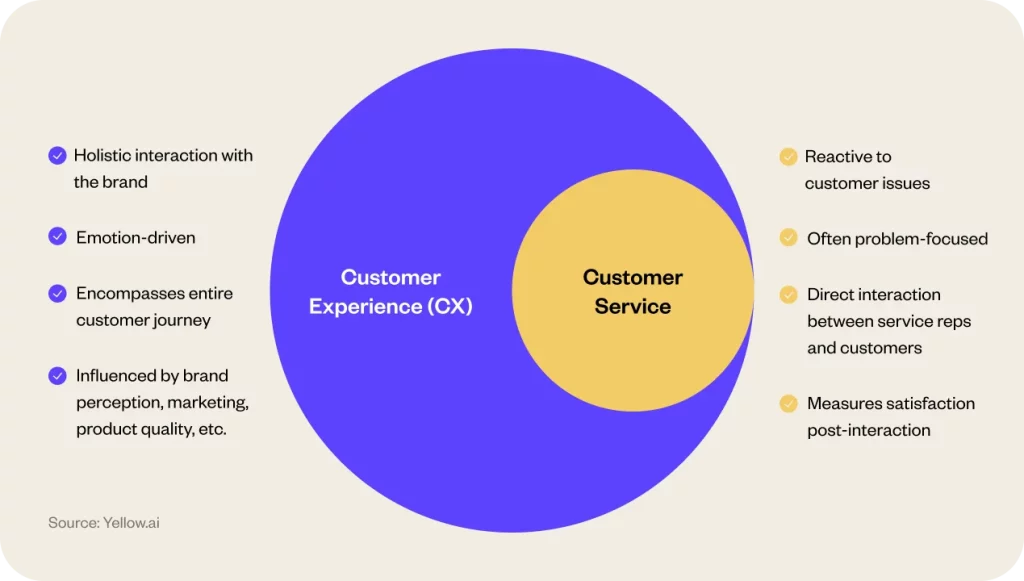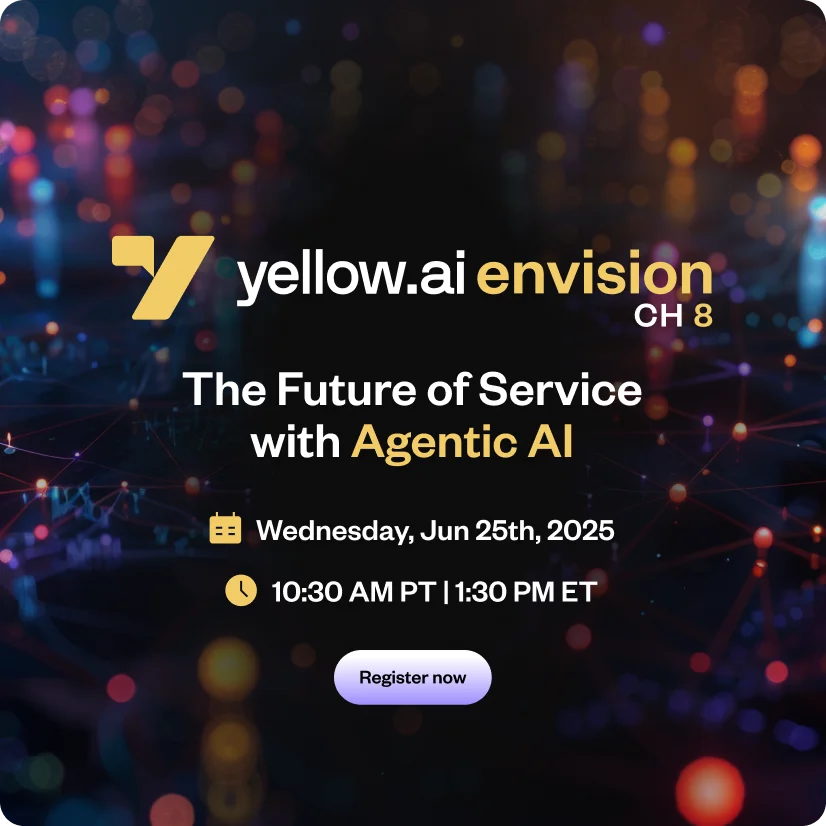Today’s business world is volatile, uncertain, complex, and ambiguous (VUCA). Hence, grasping the intricate distinctions between customer service vs customer experience and customer experience vs customer service is paramount. With evolving consumer expectations, a blend of customer experience vs customer service vs customer care is vital for a brand’s resonance. This article explores what sets customer service apart from customer experience, highlighting their importance and their interconnectedness. We’ll explore why Yellow.ai remains the go-to choice for brands eager to lead in both spheres, thanks to its AI-powered chatbot capabilities
Imagine releasing a cutting-edge app that earns enthusiastic praise for its easy-to-use design but then faces criticism for its not-quite-there customer support. Or consider rolling out a high-end software product with top-notch features but then facing backlash for a complex installation process. Such contrasts underscore the pivotal and often blurred lines between customer service and customer experience.
Chatbots are no longer just those polite little chat windows popping up when you visit a website. They’re at the forefront, leading the march towards blending customer service and experience. Research shows that by 2024, 75% of companies will move from testing AI to fully embracing it in customer interactions. They’re revolutionizing industries, setting benchmarks, and pushing companies to reimagine the definition of ‘customer interaction.’ As we dive deeper, you’ll uncover the essential differences between service and experience and, most importantly, why businesses shouldn’t confuse the two.
What is customer experience?
At its core, Customer Experience (CX) is like reading a novel. Every chapter (or interaction) plays a part in your overall impression of the story (or brand). Officially, CX represents every single interaction a person has with a brand, from that first glimmer of awareness to the emotional connection they might feel long after purchase.
Customer experience (CX) is the collective impact of all the interactions a customer has with a brand, from their first point of discovery to any post-purchase interactions. It’s a holistic view of a customer’s journey, shaped by each touchpoint they encounter along the way.
Picture this: the scent of freshly baked bread as you walk past a bakery, the cheerful wave from the baker, the warmth of the loaf in your hands, and the swift, friendly checkout process. All these shape your experience. Similarly, when you’re browsing online, it isn’t just about finding what you’re looking for. It’s about how the website feels, how quickly and helpfully customer service responds to queries, and how tailored the overall experience feels to your needs. It’s a journey, and every step counts.
Now that we’ve explored the encompassing journey of customer experience, let’s dive into a more specific aspect – customer service, and understand its unique role and significance.
Related must read:
- What is customer experience management and its best practices?
- 10 Key customer experience (CX) trends [2023]
- Conversational AI for Customer Experience?
- Customer Experience vs. Customer Service
- Customer experience in banking: Why it matters more than ever
- How can utilities companies effectively automate the customer experience?
- Automated customer service: Full guide
What is customer service?
Customer service is the strategic support and guidance provided to customers when they encounter challenges or have inquiries related to a brand’s product or service. It’s that pivotal juncture where a brand’s reputation can be enhanced or tarnished based on how customer concerns are addressed. While this service is traditionally facilitated by human representatives, increasingly, AI and automation play a significant role in this domain.
Ever had a flat tire and felt that rush of gratitude when someone stopped to help? That’s Customer Service in real life. Technically, it’s the support and guidance brands offer when you’re stuck, curious, or need assistance with what they offer. It’s the bridge that connects a brand with its consumers, ensuring that no question goes unanswered and no concern is overlooked.
Let’s think digital. You’ve just bought an e-book, but it won’t download. Frustrating, right? But then, a helpful pop-up from an AI chatbot appears, guiding you through steps to solve the problem. Still stuck? It connects you to a human representative who assists you further. This proactive and reactive assistance, where technology meets genuine human concern, is the epitome of modern customer service. Every positive interaction reinforces trust, ensuring you’re more likely to return to that brand in the future.
Customer service vs. customer experience: Understanding key differences

As businesses increasingly recognize the value of fostering customer relationships, it becomes crucial to distinguish between customer service and customer experience. While interconnected, they play distinct roles in a customer’s journey with a brand.
1. Scope: Limited interaction vs. an entire journey
Customer experience (CX)
Think of the entire lifespan of a customer’s relationship with your brand. From their first interaction, maybe seeing an advertisement or hearing a recommendation, to navigating your website, interacting with a chatbot, purchasing a product, and beyond. Every interaction contributes to CX. For instance, a user’s perception is influenced by a chatbot’s helpfulness on a website, the ease of unboxing a product, or the intuitiveness of product design. CX encompasses every touchpoint, shaping their perception and feelings about your brand.
Customer service (CS)
It is a singular, often crucial, point within that broader journey. Within this extensive journey, there will be moments when a customer seeks direct assistance or faces challenges. That’s where customer service comes in. That specific touchpoint, like an AI chatbot assisting with a malfunctioning product feature or guiding through a return process, defines service.
2. Anticipating needs vs. addressing concerns (Reactive vs. proactive approach)
Customer experience (CX)
Proactivity is at the heart of CX. It’s about being two steps ahead. Brands anticipate customer needs, creating tools and resources, and preemptively optimizing touchpoints to prevent challenges. It is like predicting a customer might need help finding usage guidelines for a product they bought from your website and proactively offering a chatbot to guide them. It’s the seamless transitions, intuitive design, and positive vibes they get throughout the journey.
Customer service (CS)
On the other hand, customer service is typically reactive. It jumps into action when a customer flags an issue or asks a question. Whether a user reaches out via chat about a delayed shipment or seeks guidance on using a feature, customer service responds to direct stimuli. It’s reactive, designed to tackle issues as they arise, ensuring the customer feels heard and valued.
3. The broad horizon vs. the focused view (Ongoing relationship vs. isolated event)
Customer experience (CX)
CX paints the broad horizon. It’s the overarching narrative of a customer’s ongoing relationship with a brand. It’s a perpetually evolving storyline, from repeat purchases influenced by past experiences to the sentiment formed through cumulative interactions. It captures the cumulative effect of all major and minor interactions across different platforms and touchpoints. It asks the question, “How does our brand make the customer feel overall?”
Customer service (CS)
It is the focused view, zoning in on specific moments of need. It examines the efficiency, effectiveness, and empathy exhibited during those interactions, aiming for quick and satisfactory resolutions. Each query addressed, each challenge tackled, and each solution provided can be quantified, measured, and optimized.
Navigating the intricate realms of both customer service and experience might seem challenging. Yet, with an AI platform like Yellow.ai, brands can seamlessly intertwine these two, ensuring that the immediate customer issues are addressed, and their entire journey is smooth, intuitive, and memorable. By leveraging advanced AI, Yellow.ai ensures every touchpoint, be it a direct customer interaction or an underlying process, is fine-tuned to create a harmonious customer journey from start to finish.
Customer experience and customer service: Distinct yet interdependent
The distinctions between customer experience (CX) and customer service are undeniable. While CX encapsulates the cumulative impression a brand leaves on its customers, customer service zeros in on targeted moments where assistance is sought. Yet, it’s crucial to understand that these elements don’t exist in isolation. Each interaction within customer service, whether a prompt resolution or a missed opportunity, incrementally molds the broader canvas of the customer experience.
Rather than placing one over the other, forward-thinking brands recognize the symbiotic relationship between them. To truly flourish in the digital age, businesses must strive to deliver exemplary customer service within the larger framework of a cohesive and delightful customer experience. This dual commitment ensures immediate concerns are addressed and paves the way for lasting customer loyalty and advocacy.
The takeaway: How to succeed at service & experience?
Both customer service and customer experience hold their unique essence in the expansive realm of brand-consumer relationships. Though distinct, these two elements converge in a symphony that determines the overall narrative a brand portrays.
Don’t just meet your customers’ expectations—exceed them

For any brand aiming for longevity and deep-rooted loyalty, the challenge is twofold: delivering impeccable customer service while also orchestrating a memorable customer experience. In today’s bustling market, where choices are abundant and patience limited, the only real differentiator is the caliber of service and experience you offer.
So, how do brands ensure they meet and exceed these demanding standards? The answer lies in choosing the right technological ally.
While many platforms tout their prowess in customer interactions, few genuinely harmonize the delicate balance between service and experience. As we segue into the conversation about why Yellow.ai stands unparalleled, consider this: While adopting AI-driven interactions, wouldn’t you prefer a platform that understands the distinction between service and experience and seamlessly crafts them into a holistic journey for your customers?
Below are the compelling reasons why Yellow.ai is a trusted partner for brands that wish to lead the pack in service and experience.
Why is Yellow.ai the best platform for AI-powered chatbots?
Navigating the digital landscape today, businesses face a buffet of choices for AI-driven customer interactions. It’s easy to get lost in the buzzwords and tech jargon. But what really matters? A platform that doesn’t just spit out robotic replies but truly understands and engages with customers just as a human would. And that’s where Yellow.ai shines.
Let’s cut through the noise and break down why Yellow.ai is a cut above the rest:
Deep learning capabilities: Unlike rudimentary chatbots, Yellow.ai’s chatbots are driven by deep learning, allowing them to understand context, tone, and intent, ensuring more human-like interactions.
Multilingual proficiency: With the ability to communicate in over 135+ languages and dialects over text and voice channels, Yellow.ai ensures brands cater to a global audience without linguistic barriers.
Omnichannel presence: Yellow.ai’s chatbots can be deployed across various digital touchpoints, whether websites, social media platforms, or even messaging apps, providing a consistent experience everywhere.
Real-time adaptability: The platform constantly learns from every interaction, refining its responses in real time to provide better solutions and answers in subsequent engagements.
Advanced analytics dashboard: Beyond interactions, Yellow.ai offers a comprehensive analytics dashboard. Brands can gauge chatbot performance, and customer satisfaction and derive insights to further optimize the customer journey.
Seamless integrations: Yellow.ai’s platform seamlessly integrates with various CRM, ERP, and other enterprise systems, ensuring that chatbots have access to all the necessary information without compromising on security.
Human handoff capability: Understanding that some queries may require human assistance, Yellow.ai has a smooth handoff mechanism to human agents, ensuring that customers always feel heard and valued.
Customization & branding: Chatbots can be tailored to match the brand’s voice, tone, and visual identity, ensuring they don’t feel out of place and resonate with the brand’s image.
Compliance and security: Adhering to global compliance standards, Yellow.ai guarantees data security, ensuring brands and their customers can interact without any reservations.
Strong support & continuous updates: With a dedicated support team and regular platform updates, Yellow.ai ensures brands are always equipped with the latest features and functionalities to enhance their customer’s experience.
In an ecosystem teeming with generic solutions, Yellow.ai rises as a holistic platform tailored for brands that refuse to settle for anything but the best. With its unmatched capabilities and deep-rooted understanding of modern customer needs, it’s evident why Yellow.ai remains the preferred choice for AI-powered chatbot solutions.
Conclusion: Crafting memorable customer journeys with smart technology
The distinction and seamless blend of customer service and experience is no longer just a luxury—it’s a necessity. In an era where every customer interaction can tip the scales, brands must deftly manage and innovatively enhance every touchpoint.
With various options at consumers’ fingertips, the true differentiator remains the caliber of service and experience offered. As we champion the prowess of AI in shaping this journey, the choice is clear: Ensuring a seamless blend of service and experience is paramount in a market inundated with choices. Equip your enterprise with an AI solution that understands and elevates this distinction. Don’t just adapt; lead the change with Yellow.ai. Schedule a demo now.
Witness the transformation in real time with Yellow.ai. Book a demo today.






















